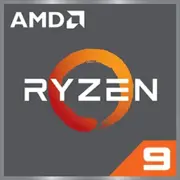AMD Ryzen 9 7845HX

AMD Ryzen 9 7845HX: The Power of Dragon Range in Laptop Form. Complete Processor Breakdown
Architecture and Process Technology: Zen 4, 5 nm, and 12 Cores
The AMD Ryzen 9 7845HX processor, codenamed Dragon Range, is based on Zen 4 architecture and is manufactured using TSMC's 5-nanometer FinFET process. It is one of AMD's most advanced mobile chips, targeted at high-performance laptops.
Cores, Threads, and Cache Memory
- 12 cores and 24 threads — a configuration that places the 7845HX on par with desktop CPUs. For comparison, the previous generation Ryzen 9 6900HX (Zen 3+) had 8 cores.
- Base clock — 3.0 GHz, maximum turbo frequency (Boost) — up to 5.2 GHz. This allows the chip to adapt to tasks: saving energy in simple scenarios and unleashing its potential under load.
- L3 cache is increased to 64 MB — double that of the Ryzen 9 6900HX (32 MB). This is critically important for gaming and applications that actively work with large amounts of data (e.g., rendering 3D scenes).
Integrated Graphics: Radeon 610M
The built-in GPU, Radeon 610M, is a weak point of the processor. It is a 2-core graphics chip with a frequency of up to 1.5 GHz, sufficient only for:
- Watching 4K videos.
- Working in office applications.
- Casual gaming at low settings (e.g., CS:GO at 720p will provide about 30-40 FPS).
For gaming or video editing, a discrete graphics card (e.g., NVIDIA RTX 4070 or Radeon RX 7600M XT) is essential.
Power Consumption and TDP: A Balance Between Power and Efficiency
TDP of 55 W — a typical indicator for top mobile processors. However, in turbo mode, power can briefly reach 75-80 W, necessitating an efficient cooling system.
How is Power Consumption Managed?
- Precision Boost 2 — automatically increases core frequency if temperature conditions permit.
- Eco Mode (available in laptop settings) — limits TDP to 45 W to reduce heat and noise, which is useful when operating on battery.
- Voltage optimization algorithms — reduce power consumption during idle time.
Performance: Tests in Gaming, Rendering, and Everyday Tasks
Geekbench 6 and Synthetic Tests
- Single-core score: 2638 points — this is 18% higher than the Ryzen 9 6900HX (Zen 3+) and roughly equivalent to the Intel Core i9-13900HX.
- Multi-core score: 13649 points — here, AMD pulls ahead thanks to its 12 cores. For comparison, the Intel Core i7-13700H (14 cores) scores about 12,000 points.
Real-World Scenarios
1. Office Work (Chrome with 20+ tabs, Excel, Zoom):
The processor is loaded at 10-15%, frequency drops to 2.1-2.5 GHz for energy saving. Temperature stays around 45-50°C.
2. Video Editing in DaVinci Resolve:
Rendering a 10-minute 4K video takes about ~8 minutes (compared to ~12 minutes with the Ryzen 7 6800H). All cores are at 100% usage, with frequency maintained at 4.3-4.5 GHz.
3. Gaming (paired with RTX 4070):
- Cyberpunk 2077 (Ultra, DLSS Quality): 75-85 FPS.
- Hogwarts Legacy (High): 90-100 FPS.
Turbo mode activates in peak scenes, but due to the 55 W TDP, the processor sometimes "throttles" (reduces frequency) in compact cases.
Usage Scenarios: Who is the Ryzen 9 7845HX For?
1. Gamers who want to play at 1440p or 4K with discrete graphics.
2. Professionals: programmers (building large projects), video engineers, 3D designers.
3. Multitaskers — those who run virtual machines, code editors, and stream simultaneously.
Not recommended for those looking for an ultra-portable laptop for travel — due to the high TDP, battery life rarely exceeds 4-5 hours.
Battery Life: How Long Will the Laptop Last?
With active use (gaming, rendering), battery life is around 1.5-2 hours. In moderate mode (web surfing, office work) — 4-6 hours thanks to:
- Adaptive Power Management — dynamically disabling unused cores.
- "Battery Saver" mode in Windows, which limits CPU frequency.
- Radeon driver optimizations for iGPU — in simple tasks, the system switches to integrated graphics to save charge.
Tip: Look for laptops with a battery of at least 90 Wh and support for USB-C Power Delivery for fast recharging.
Comparison with Competitors: AMD, Intel, Apple
AMD Ryzen 9 7945HX (16 Cores)
A more powerful sibling of the 7845HX. The difference in multi-threaded tasks can be up to 25%, but it costs $300-400 more.
Intel Core i9-13900HX (24 Cores, 32 Threads)
In gaming — parity, in rendering Intel sometimes wins due to hyper-threading. However, the TDP of up to 157 W makes it less preferable for mobile devices.
Apple M2 Max (12 Cores)
In tasks optimized for ARM (e.g., Final Cut Pro), Apple is faster. But for Windows programs and games, the Ryzen 9 7845HX is preferred.
Pros and Cons
Strengths:
- Best-in-class multi-threaded performance.
- Support for DDR5-5200 and PCIe 5.0.
- Efficient 5-nm process technology.
Weaknesses:
- Weak integrated graphics.
- Heating in compact cases.
- High price of laptops with this CPU (from $2000).
Laptop Selection Recommendations
1. Type of Device:
- Gaming models (ASUS ROG Strix, Lenovo Legion) — focus on cooling and discrete graphics.
- Mobile workstations (MSI CreatorPro) — screens with 100% DCI-P3 color accuracy, ISV certification.
2. What to Look For:
- Cooling system — at least 2 fans, 5 heat pipes.
- RAM — from 32 GB DDR5.
- Storage — 1 TB PCIe 4.0 SSD.
Final Verdict
AMD Ryzen 9 7845HX is a processor for those who are unwilling to sacrifice performance for mobility. It is ideal for:
- Gamers playing at resolutions higher than Full HD.
- Engineers and designers working with resource-intensive applications.
- Enthusiasts looking for a laptop "to grow into" that supports new standards (PCIe 5.0, DDR5).
Key benefits: flagship multi-threaded power, readiness for future upgrades, and optimal price-to-performance ratio in its segment.
Basic
CPU Specifications
Memory Specifications
GPU Specifications
Miscellaneous
Benchmarks
Compared to Other CPU
Share in social media
Or Link To Us
<a href="https://cputronic.com/cpu/amd-ryzen-9-7845hx" target="_blank">AMD Ryzen 9 7845HX</a>